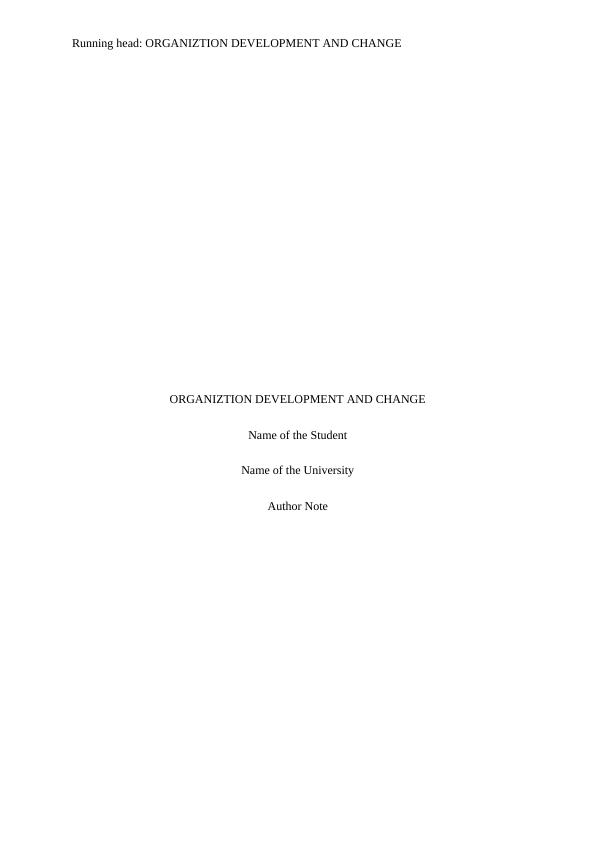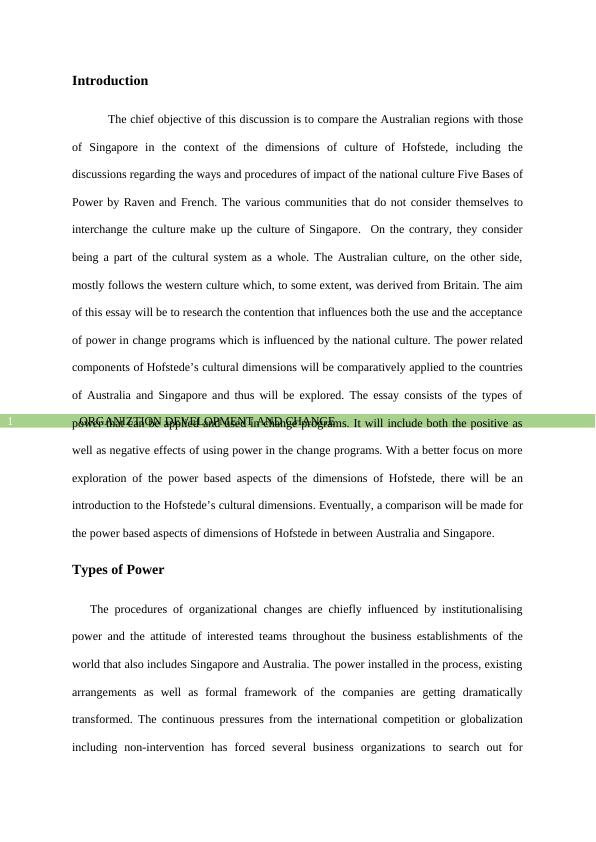Comparison of Australian and Singaporean Culture: Power and Change Programs | Desklib
Added on 2022-11-17
11 Pages2821 Words191 Views
Running head: ORGANIZTION DEVELOPMENT AND CHANGE
ORGANIZTION DEVELOPMENT AND CHANGE
Name of the Student
Name of the University
Author Note
ORGANIZTION DEVELOPMENT AND CHANGE
Name of the Student
Name of the University
Author Note

ORGANIZTION DEVELOPMENT AND CHANGE1
Introduction
The chief objective of this discussion is to compare the Australian regions with those
of Singapore in the context of the dimensions of culture of Hofstede, including the
discussions regarding the ways and procedures of impact of the national culture Five Bases of
Power by Raven and French. The various communities that do not consider themselves to
interchange the culture make up the culture of Singapore. On the contrary, they consider
being a part of the cultural system as a whole. The Australian culture, on the other side,
mostly follows the western culture which, to some extent, was derived from Britain. The aim
of this essay will be to research the contention that influences both the use and the acceptance
of power in change programs which is influenced by the national culture. The power related
components of Hofstede’s cultural dimensions will be comparatively applied to the countries
of Australia and Singapore and thus will be explored. The essay consists of the types of
power that can be applied and used in change programs. It will include both the positive as
well as negative effects of using power in the change programs. With a better focus on more
exploration of the power based aspects of the dimensions of Hofstede, there will be an
introduction to the Hofstede’s cultural dimensions. Eventually, a comparison will be made for
the power based aspects of dimensions of Hofstede in between Australia and Singapore.
Types of Power
The procedures of organizational changes are chiefly influenced by institutionalising
power and the attitude of interested teams throughout the business establishments of the
world that also includes Singapore and Australia. The power installed in the process, existing
arrangements as well as formal framework of the companies are getting dramatically
transformed. The continuous pressures from the international competition or globalization
including non-intervention has forced several business organizations to search out for
Introduction
The chief objective of this discussion is to compare the Australian regions with those
of Singapore in the context of the dimensions of culture of Hofstede, including the
discussions regarding the ways and procedures of impact of the national culture Five Bases of
Power by Raven and French. The various communities that do not consider themselves to
interchange the culture make up the culture of Singapore. On the contrary, they consider
being a part of the cultural system as a whole. The Australian culture, on the other side,
mostly follows the western culture which, to some extent, was derived from Britain. The aim
of this essay will be to research the contention that influences both the use and the acceptance
of power in change programs which is influenced by the national culture. The power related
components of Hofstede’s cultural dimensions will be comparatively applied to the countries
of Australia and Singapore and thus will be explored. The essay consists of the types of
power that can be applied and used in change programs. It will include both the positive as
well as negative effects of using power in the change programs. With a better focus on more
exploration of the power based aspects of the dimensions of Hofstede, there will be an
introduction to the Hofstede’s cultural dimensions. Eventually, a comparison will be made for
the power based aspects of dimensions of Hofstede in between Australia and Singapore.
Types of Power
The procedures of organizational changes are chiefly influenced by institutionalising
power and the attitude of interested teams throughout the business establishments of the
world that also includes Singapore and Australia. The power installed in the process, existing
arrangements as well as formal framework of the companies are getting dramatically
transformed. The continuous pressures from the international competition or globalization
including non-intervention has forced several business organizations to search out for

ORGANIZTION DEVELOPMENT AND CHANGE2
renewed and fresh organizational forms and different models for managing the employees in
their companies as well as with the societies in which they are serving. The power including
both the responsibilities and liability are being fixed to the organization’s executives. There is
a constant change in the mode of work and roles played by labour unions. The basic changes
of the organizations are transferring the latest power balance. The forces throughout the
companies are working on the maintenance of the balance which can affect the changes while
other forces can inspire the change processes. Organizational change, resistance and power
are intimately associated with one another. The ‘Five Bases of Power’ by French and Raven
have chosen out five kinds of power. They are as follows:
1. Coercive – Here the power is derived from a person’s ability for ordering punishment
for other people due to non-conformity. For instance, being afraid of losing the yearly
bonus or even losing a job. In this case, the seniors can dominate the people by the
punishment or removal scare from the respective positions held by the employees.
2. Reward – In this base, the power is derived from a person’s ability for issuing
rewards. For instance, issuing time off in lieu. Here, the employees or other people
can be influenced by supplying them promotions and accolades, in order to motivate
them to perform better.
3. Legitimate – Here, the power is obtained from one’s formal right of delivering the
orders or directives due to their positions which are held in the business. For instance,
the CEO has the authority or power to deliver the strategy of the company. In this
case, the seniors can influence by taking the help of the positions hold by them in
offices or society.
4. Expert – The power, here, is derived from a person’s experience or knowledge. For
example, a senior surgeon or doctor passes the knowledge in which he is an expertise.
renewed and fresh organizational forms and different models for managing the employees in
their companies as well as with the societies in which they are serving. The power including
both the responsibilities and liability are being fixed to the organization’s executives. There is
a constant change in the mode of work and roles played by labour unions. The basic changes
of the organizations are transferring the latest power balance. The forces throughout the
companies are working on the maintenance of the balance which can affect the changes while
other forces can inspire the change processes. Organizational change, resistance and power
are intimately associated with one another. The ‘Five Bases of Power’ by French and Raven
have chosen out five kinds of power. They are as follows:
1. Coercive – Here the power is derived from a person’s ability for ordering punishment
for other people due to non-conformity. For instance, being afraid of losing the yearly
bonus or even losing a job. In this case, the seniors can dominate the people by the
punishment or removal scare from the respective positions held by the employees.
2. Reward – In this base, the power is derived from a person’s ability for issuing
rewards. For instance, issuing time off in lieu. Here, the employees or other people
can be influenced by supplying them promotions and accolades, in order to motivate
them to perform better.
3. Legitimate – Here, the power is obtained from one’s formal right of delivering the
orders or directives due to their positions which are held in the business. For instance,
the CEO has the authority or power to deliver the strategy of the company. In this
case, the seniors can influence by taking the help of the positions hold by them in
offices or society.
4. Expert – The power, here, is derived from a person’s experience or knowledge. For
example, a senior surgeon or doctor passes the knowledge in which he is an expertise.

ORGANIZTION DEVELOPMENT AND CHANGE3
In this case, the seniors can influence the people with the aid of the gained knowledge
in their work life.
5. Referent – The power, in this base, is obtained from being trustful or respectful. For
example, huge respect is earned by a manger who treats each and every employee
equally and gives them proper respect. In this case, the seniors are capable enough to
handle the problems by sharing healthy and strong relations with other people in the
work places and societies.
Positive and Negative Aspects
The positive aspects of using the power as change programs can be described as
below:
1. Power as change programs aids to raise the potential capability of the employees in order
to result a target within the business operations of a company, whether it is in Australia or
Singapore or any other regions of the world.
2. This will aid the organizations to take prompt decisions by the senior managers or leaders
of the business houses in case if urgent conditions.
3. It decides in compliance when the teams or the employees in the organizations depend on
each other.
4. No substitute strategies need to be followed or used while following the power as change
programs.
Negative Aspects
1. The power as change programs involves the fearless up and down approaches to change,
which may restrict the work balance within the organizations.
In this case, the seniors can influence the people with the aid of the gained knowledge
in their work life.
5. Referent – The power, in this base, is obtained from being trustful or respectful. For
example, huge respect is earned by a manger who treats each and every employee
equally and gives them proper respect. In this case, the seniors are capable enough to
handle the problems by sharing healthy and strong relations with other people in the
work places and societies.
Positive and Negative Aspects
The positive aspects of using the power as change programs can be described as
below:
1. Power as change programs aids to raise the potential capability of the employees in order
to result a target within the business operations of a company, whether it is in Australia or
Singapore or any other regions of the world.
2. This will aid the organizations to take prompt decisions by the senior managers or leaders
of the business houses in case if urgent conditions.
3. It decides in compliance when the teams or the employees in the organizations depend on
each other.
4. No substitute strategies need to be followed or used while following the power as change
programs.
Negative Aspects
1. The power as change programs involves the fearless up and down approaches to change,
which may restrict the work balance within the organizations.

End of preview
Want to access all the pages? Upload your documents or become a member.
Related Documents
Organization Development and Changelg...
|11
|2748
|207
The Role of Power in Organisational Change: A Comparison of Singapore and Australia Based on Hofstede's Cultural Dimensionslg...
|8
|2730
|259
Organizational Change Management Assignment PDFlg...
|13
|3395
|104
Implications of National Culture on Acceptance of Organizational Changelg...
|13
|2909
|94
Hofstede’s Cultural Dimesnion and Five Bases of Powerlg...
|9
|2950
|83
Hofstede Culture Dimension | Essaylg...
|11
|2378
|9
